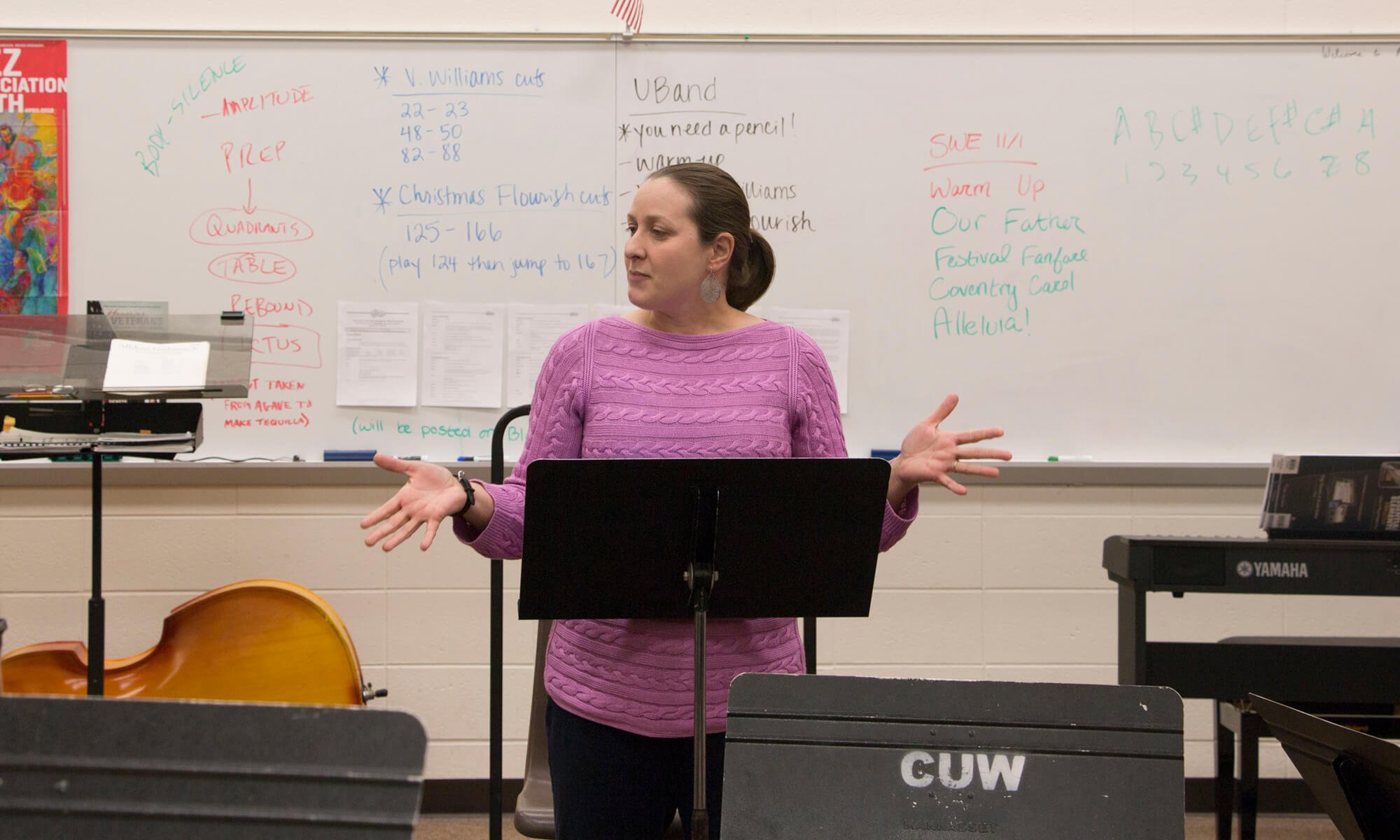
In 2006, Concordia University Wisconsin's music department piloted an innovative program to help students turn their passion for music into a care giving career.
More than a decade later, the Certificate in Music Therapy Equivalency program—a collaboration with Alverno College—is still going strong and has plenty of graduate success stories under its belt.
One such story is that of Brenna (Beecroft) Liebold, MT-BC, WMTR, who owns her own music therapy business, Living Melodies. Liebold graduated from Concordia in 2001, before the program was even formed, and then went on to complete the music therapy certificate program at Alverno in 2004. With her passion for the field, Liebold helped pave the way for the launch of the joint program that is now benefiting other CUW students as well.
On Wednesday, Nov. 7, Liebold returned to campus to speak with the latest cohort of music therapy students, and afterwards, she offered insights on some of the common misconceptions that exist about the profession.
- Myth: You have to be musically inclined to benefit from music therapy.
Liebold: At the end of the day, we all have music in our lives. We use it to make everyday events memorable and special events even more special. We use it at weddings, church services, birthdays…we even have a special song for people’s birthdays! So whether people immediately identify themselves as being musically inclined or not, the fact is that we are all united on some level by music.
That being said, it’s a music therapist’s job to then determine what type of music to use to best reach patients and to teach them how to use it most effectively in their lives. The music therapist knows how best to manipulate music or how to pick out music that will produce the desired effect.
- Myth: There aren’t many jobs available for music therapists.
Liebold: That was the first thing my father asked me when I told him I wanted to go into music therapy: “Will you have a job?” People don’t realize that in Wisconsin right now, there are more jobs than can be filled. At the moment, I personally have two open positions within my business that I am having a hard time filling. There’s a lot of jobs out there for music therapists and the demand doesn’t seem to be waning.
- Myth: If you’re not into drum circles and that “hippie” vibe, you won’t like music therapy.
Liebold: Honestly, I was kind of worried that I was going to encounter that within my first year as a student, but just like any other therapy service, there’s a variety of approaches to the discipline. I personally was really drawn to a medical model. It combines science and research to produce a medical-based approach. Yes, some people can incorporate drumming for connecting with different parts of the mind and body, but it’s definitely not all drum circles and feel-good circles.
- Myth: Classical music is the best genre to use within the field.
Liebold: It’s only so if the person receiving music therapy has an affinity for classical music. It’s never just one type of music. Music therapists have to have a really broad repertoire of music knowledge and skills. That was one of the things that drew me to the profession in the first place because I grew up with such a range of music in my life. My grandparents are from Austria so I was introduced to polkas at a young age, and then my parents grew up in the ’60s so I was exposed to the Doobie Brothers and the Righteous Brothers. As a teenager, I got turned on to music from the ’40s and ’50s—music that was not normal a teenager to love—and I even went through stages when I was a grunge punk kind of girl. I’ve always been drawn to music that I could sing because that’s my preferred instrument, my voice. Along the way I learned to play guitar and whatever instrument needed to accompany my signing, and now I use those skills as well within my career.
- Myth: I probably won’t benefit from music therapy because I’m not in pain.
Liebold: This might sound kind of crazy but I’ve helped everything from constipation to a manic episode. Anyone can benefit from music therapy. We may not all be in physical pain, but most of us could benefit from slowing down a bit in our hectic lives. Music therapy is not only taking a problem and trying to solve it, it’s using the person’s strengths and preferences to get them to where they need to be, so the services will look very different depending on who the patient is. A child receiving music therapy in a school setting is going to have a completely different experience than someone who is in hospice, for example.
Music therapy can also be used as a compliment to other therapies, like physical therapy, occupational therapy, and so on. Or if someone for example refuses pain medication, it can be used in lieu of medication.
Learn more about the Certificate in Music Therapy equivalency program here.
— This story is written by Kali Thiel. Kali was Director of University Communications until April, 2025.
If this story has inspired you, why not explore how you can help further Concordia's mission through giving.